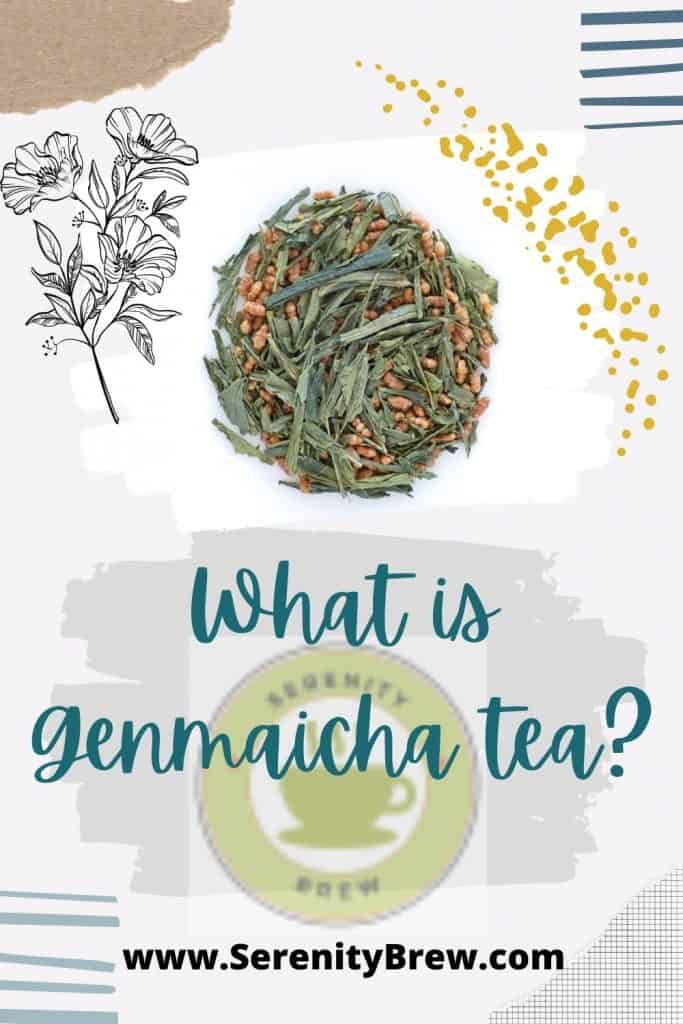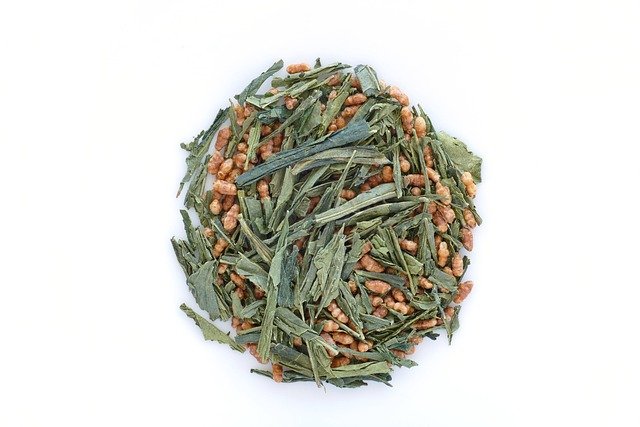
Genmaicha is the Japanese name for a mixture of green tea and toasted cereals, basically rice.
Let’s break down the definition and you’ll see how wonderful:
Japanese: Its origin is Japanese and Japanese green teas are characterized by their intense sweet and vegetable flavor coming from the steam processing technique, compared to Chinese teas.
Green tea blend: We normally differentiate the types of teas into two broad categories: pure and blends.
Pure teas are those created only with the elements of the tea tree or Camellia sinnesis. Its leaves are normally used.
Tea mixes (do not confuse it with blends that are a mixture of different pure teas) are made with pure teas and other food ingredients such as fruits, cereals, spices, etc.
Roasted Cereals– This tea is a blend of green tea and roasted cereals.
The genmaicha can be with different cereals: wheat, corn, etc. But generally rice is used.
But it is not raw rice (don’t think that it is just adding a little white rice to the tea and that’s it) but it is made with toasted rice that has not been previously cooked.
To do this, the whole grains of rice are selected and roasted in a rotating drum for a few minutes at a temperature between 150 and 175º C, where the sugars and starch are caramelized to obtain a sweet taste.
Sometimes the heat causes the grain to burst and a white “popcorn” appears that is called Hana and is generally added to decorate the tea, not to flavor it.
That is why it is often called “popcorn tea“. That is, Japanese green tea deliciously mixed with roasted rice grains
What is the origin of Genmaicha?
Normally when we talk about the origins or history of teas we come across legends and myths that remind us of “Chinese tales”.
The Genmaicha could not be less and we are going to tell you some little stories about him.
The “poetic” legend is that of the 15th century samurai who rested before the battle by preparing tea. A servant named Genmai spilled some roasted rice from his food into the tea. For this samurai, tea was highly appreciated and even more so at that time. Angered at having spoiled his tea, he had Genmai’s head cut off. When he tasted the tea he found that it tasted really delicious. In his homage, he named this combination of green tea with toasted rice Genmai. That is why he calls him Genmaicha, Genmai from the name of the servant, plus Cha, tea in Japanese.
How nice! But it is also a coincidence that Genmaicha is the combination of three Japanese words of Gen (dark), mai (rice) and cha (tea) and that in other countries like Korea neyonmicha (“green rice tea”) was consumed even before Japan. integral”).
The “religious” legend could not be missing and consisted that the monks used it in their fasts for its nutritional properties of the cereal and exciting of the tea.
Then we have the “economic” legend that tells Kyoto was the birthplace of Genmaicha, where a tea producer mixed roasted rice (as a filler) with his cheaper blends so that the poor could afford “tea” and get some vitamins and minerals.
It is true that attempts have always been made to adulterate tea with cheaper products to obtain greater benefit, especially when tea was considered almost like a medicine. But the adulteration is so crude (even a blind man can see that the grains of roasted rice do not look like tea leaves) that it is difficult to believe.
As always the origins are confusing and numerous. The same thing always happens, it occurs to many people from different places and at the same time like the discovery of the submarine!
What seems more credible is that in Japan and Korea it occurred to them almost simultaneously to combine two basic ingredients in their diet for centuries: green tea and rice, that is, Mugicha and tea. In addition, this combination had the advantages of its exquisite flavor, its price and more nutritional power than tea in times of need.
Which is the best Genmaicha?
It is a difficult question to answer being a green tea mixed with roasted rice.
It can be made with any type of Japanese green tea: Sencha, Bancha, Gyokuro, although the vast majority are with Bancha or Sencha since it is a shame to use Gyokuro for a mixture (it is like using the best wine to make a sangria).
The other variable is the amount of toasted rice we use for the mix. Toasted rice gives it the characteristic sweet flavor.
One of the best is with Sencha tea and a medium content of toasted rice, which makes the flavor balanced between the sweetness of the starch and the bitterness of green tea.
There is a variety of Genmaicha that is matcha-irigenmaicha, basically it is a Genmaicha that has added matcha tea (ground green tea) to give a more intense flavor of green tea and a green color to the infusion.
The amount of “popcorn” or Hana does not have to be high since it is an aesthetic product, that is, it makes it pretty and flowery but the popcorn does not add flavor. For us it has to have a very low percentage, almost anecdotal.
Properties of Genmaicha
The properties of this tea are very easy to deduce, since it is a green tea with roasted rice, therefore it has all the properties of green tea, rice and the combination of the two ingredients. Think that it is the sum of the ingredients and you will easily understand it:
The properties of green tea, the basis of Gemaicha can be summarized in that it is a product
- astringent
- stimulating
- antioxidant
- slimming
- diuretic
The properties of toasted rice can be summarized as:
- Your energy intake
- Its contribution in mineral salts
The combination of the two products makes the contribution of the tea content in the infusion lower than in a pure tea, that is:
- It has less protein than green tea, which is normally lower than black tea. We add less tea per gram of infusion
- It has a few more calories than a green tea (3 calories per cup and I say 3 calories in a usual diet of 1500-2000 calories per day)
- So basically it has the same properties as a green tea, although a little “reduced” by using less tea and more rice.
Benefits of Genmaicha
The main benefit of genmaicha is… Its unmistakable flavor!
Its flavor alone is worth being a fan of.
The benefits of this tea are the benefits of green tea, neither more nor less, since the benefits of roasted rice infusion are very scarce.
If we dare to indicate the generic benefits of green tea produced by the two fundamental components of tea:
- Catechins with their antioxidant power
- Theine with its stimulating power
Some colleagues indicate that it has less theine content than green tea, which is true because when it contains rice, per gram consumed it lowers the content of tea and therefore of theine, but IT DOES HAVE THEINE, so for insomnia…
Of course, if it’s matcha-irigenmaicha, that is, genmaicha with matcha.
If you are allergic to gluten or nuts, you should take into account the cross-contamination that this product has, since the same facilities are used for roasting nuts.
We insist, the best benefit of Genmaicha is its flavor!
How to prepare Genmaicha tea?
Preparing a Genmaicha is as easy as preparing any green tea:
- Quantity: 2.5 – 3 grams for a generous cup of tea. One teaspoon per cup
- Water temperature: 70-80ºC
- Infusion time: 2-4 minutes.
Since you are not going to control the temperature much, the tea will be stronger the longer it is infusing. If you like a strong and intense flavor, leave it longer. If you find it very intense, use less sheet and a little less time.
The result is a pale yellow broth with a toasted nutty flavor. It’s like drinking a rice cake with shades of grass, fresh and sweet. It can be consumed both hot and cold. Believe it or not, it is very good as it is cold in summer.
At the beginning of the article, they usually offer it as a drink in oriental restaurants since it seems to marinate well with nigirs or suhis. Personally, I think it’s best taken as an after-meal drink or as a mid-morning or late-afternoon drink. I don’t really believe in “regional” combinations like bean stew and cider or seafood and albariño, besides cleaning the mouth of the taste of nigirs with a drink flavored with toasted rice…it’s not much cleaning the taste!
This typical and well-known Japanese tea has its own personality to be enjoyed and savored on its own and not as a meal drink.
Conclusions about Genmaicha tea

Genmaicha is a typical and classic Japanese tea made up of a mixture of green tea, usually sencha or bancha, with toasted rice. Its appearance is that of green tea with brown grains of rice and some white popcorn.
Its true origin is unclear since it appeared simultaneously in Korea ( hyeonmicha ) and in Japan by mixing two basic ingredients of their diet: rice and tea. In addition, this mixture lowered the price of a cup of tea.
Its properties are the same as any green tea : astringent, stimulant, antioxidant, slimming and diuretic , although the theine content is usually lower than that of pure green teas. The best benefit of Genmaicha tea is its sweet nutty flavor that makes it unmistakable and delicious.
Its preparation is very simple, just add 2.5 – 3 grams in about 200 ml of hot water between 70 – 80 ºC for 2-4 minutes, according to your preferences in terms of flavor intensity. The result is a very aromatic broth with a pale yellow color and a nutty flavor that you can drink both hot and cold.
It is worth enjoying it in the morning or after eating, although it is very fashionable to combine it with nigirs or sushi.
It’s unique, fabulous and worth taking!
